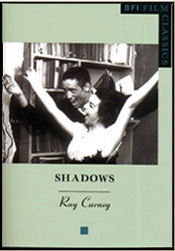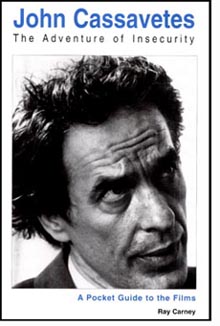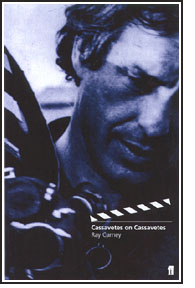 |
Jim
McKay
In Print
Jim McKay
talks with Ray Carney about writing about John Cassavetes
Filmmaker
Magazine (Fall 2001) |
I have a confession to make. About seven
or eight years ago, I came upon a very early, bootleg copy of a
book of interviews and commentary called Cassavetes on Cassavetes.
It was about 100 pages long and was a Xerox of a Xerox of a Xerox,
but in its pages I found some of the most inspiring thoughts about
film, art and life that I'd ever read. It quickly became the most
important book on my shelf.
Confession number two is that the book meant
so much to me that I Xeroxed the Xerox and gave it out to fellow
believers a number of times. I didn't know if the book would ever
find a publisher, and, in the meantime, how could I keep this crucial
information (both practical and spiritual) from others?
In the end, I think it'll work out fine.
The book has finally been published and, at over 500 pages, is so
much more jam-packed with material I'm certain that everyone who
got the bootleg from me will run out and buy the official version.
Over the course of shooting two features
(Girls Town and Our Song) and producing half a dozen
others, Ray Carney's Cassavetes on Cassavetes (Faber and
Faber, Inc., $25, paperback, 544 pages) sat by my bedside like a
bible. Late at night, while obsessing over some concern about tomorrow's
shoot, or the next day's credit-card bill, or an upcoming meeting
with a distributor, I'd open up the book to a random page and read.
Just a passage or a page, it never took much. In those pages, I
found the strength, support and spirit to go on. Sound a bit over-dramatic?
Well, if you're a filmmaker or a film fan interested in cinema outside
the Hollywood system, pick up the book for yourself and start reading.
You'll see.
Over a period of a few weeks, I engaged
in an e-mail conversation with Carney, a professor of film at Boston
University who maintains a web site devoted to independent film
at www.Cassavetes.com. We talked about independent film and the
influence of John Cassavetes's work.
Jim McKay:
You have three new books out this month. Describe them, the viewing
guide and the Shadows book very briefly, and Cassavetes
on Cassavetes more at length.
Ray Carney:
One of the reasons there are so few film really good books about
real
indies (as opposed to media-promoted figures like Stone and Spielberg)
is because the film book business is not that different from
the
movie business. Book proposals are judged in terms of their “box-office
potential.” An indie writer has to overcome obstacles, adapt to
circumstances, take chances, and pay the price – in emotions
and dollars – just
like an indie filmmaker. The only difference is that there is a
heck of a lot less money at stake in the book biz! You might
think
academic presses would be less commercially driven than the trade
houses, but they are even worse – since every book has
to be approved by a committee of film professors, who are always
the last
to know
anything new about film and are complete fashion slaves to media-created
trends and fads. In a nutshell, getting anything into print
about
Cassavetes is a struggle.
 Believe
it or not, the Shadows book was originally going to be about
Faces! I have tons of material on the making of Faces
– drafts of the stage play the film was based on that Cassavetes
gave me, hours of tape-recorded behind-the-scenes stories by cast
and crew members, and access to prints of the film with entirely
different scenes from the release version. I proposed a book on
it to the British Film Institute for their “Film Classics” series,
but the editor turned me down, saying it wasn't on their list of
masterworks. Believe
it or not, the Shadows book was originally going to be about
Faces! I have tons of material on the making of Faces
– drafts of the stage play the film was based on that Cassavetes
gave me, hours of tape-recorded behind-the-scenes stories by cast
and crew members, and access to prints of the film with entirely
different scenes from the release version. I proposed a book on
it to the British Film Institute for their “Film Classics” series,
but the editor turned me down, saying it wasn't on their list of
masterworks.
He counterproposed
a book on Shadows (which was on the list largely because
it plugged into the currently fashionable interest in jazz orchestration
and African-American characters). Fortunately, I had devoted years
to studying the film, and had just as much material about it, dating
back to a “Rosebud” conversation with Cassavetes shortly before
his death, where he told me that most of the important scenes in
his so-called “masterpiece of improvisation” were actually written
by a Hollywood screenwriter. You should have heard him laugh when
he said it. He had fooled the critics all those years! I had already
interviewed everyone involved in the production, so I used that
material to tell the real story of the making of one of the early
masterworks of the American independent movement.
 The
second book, John Cassavetes: The Adventure of Insecurity,
came out of the fact that I had always wanted to do a short, concise
overview of Cassavetes' life and work for general filmgoers –
a skinny paperback you could stuff in your pocket and take with
you to a festival that would give basic information and suggest
things to watch and notice. For more than ten years I had been writing
program notes about Cassavetes' work for film festivals and handing
them out as well as giving lectures and conducting question and
answer sessions following the screenings, and it just seemed like
common sense that I should gather some of that material together
and make it more conveniently available to viewers. (I was getting
tired of running around the country attending all those screenings.
And getting even more tired of running up to Kinko's between screenings
and paying my own money to make more copies of the essays when the
ones I had ran out and the festivals invariably told me their copy
machine was broken! I'll never forget one particularly frantic,
rainy night before a big screening at Anthology Film Archives!)
But when I approached various publishers, they all told me the same
thing – first, that they weren't sure that they would sell
enough copies; and second, that they only published books of a certain
minimum length and price. No dice on a viewer's guide. It was a
moment of truth for me. For years, I had been writing all these
essays praising indie filmmakers for putting their money where their
mouths were, and I was faced with the question of whether I was
brave enough to do the same thing. So a close friend and I pooled
our savings, got together ten thousand dollars, and published the
book on our own. That's why, at least as of right now, the only
way to get it is through Amazon or my web site. I'm living the indie
dream and nightmare. You self-finance it, you have to self-distribute it! The copies are sitting in boxes in my office. (Click here to read another statement about the financial realities of serious, scholarly research and publication.) The
second book, John Cassavetes: The Adventure of Insecurity,
came out of the fact that I had always wanted to do a short, concise
overview of Cassavetes' life and work for general filmgoers –
a skinny paperback you could stuff in your pocket and take with
you to a festival that would give basic information and suggest
things to watch and notice. For more than ten years I had been writing
program notes about Cassavetes' work for film festivals and handing
them out as well as giving lectures and conducting question and
answer sessions following the screenings, and it just seemed like
common sense that I should gather some of that material together
and make it more conveniently available to viewers. (I was getting
tired of running around the country attending all those screenings.
And getting even more tired of running up to Kinko's between screenings
and paying my own money to make more copies of the essays when the
ones I had ran out and the festivals invariably told me their copy
machine was broken! I'll never forget one particularly frantic,
rainy night before a big screening at Anthology Film Archives!)
But when I approached various publishers, they all told me the same
thing – first, that they weren't sure that they would sell
enough copies; and second, that they only published books of a certain
minimum length and price. No dice on a viewer's guide. It was a
moment of truth for me. For years, I had been writing all these
essays praising indie filmmakers for putting their money where their
mouths were, and I was faced with the question of whether I was
brave enough to do the same thing. So a close friend and I pooled
our savings, got together ten thousand dollars, and published the
book on our own. That's why, at least as of right now, the only
way to get it is through Amazon or my web site. I'm living the indie
dream and nightmare. You self-finance it, you have to self-distribute it! The copies are sitting in boxes in my office. (Click here to read another statement about the financial realities of serious, scholarly research and publication.)
 The
third book, Cassavetes on Cassavetes, marks an era in my
life, something like ten or fifteen years of work. The origin was
a series of conversations I had with Cassavetes in the final decade
of his life. He said so many wonderful things that I thought it
would have been a shame to keep them to myself and not share them
with the world. The book is his own personal account of how he made
his movies – from the scripting, fund-raising, and planning,
to assembling the crew, struggling to get them into theaters, and
interacting with the press. I thought it was unbelievably great
stuff, but it too was a hard sell. I spent years trying to persuade
a publisher to print it. Oxford turned me down. Pantheon. Cambridge.
And a zillion others. Even Faber, who eventually published the book,
turned me down the first time I queried them – around 1992
or 1993. Most of them didn't even ask to see the manuscript before
they turned me down. In the early and mid-1990s Cassavetes was just
not a big enough name. I remember one editor saying, “Well, if it
were only Woody Allen or Oliver Stone, it would be different.” At
least she was honest. Meanwhile, years went by. I was almost at
the point of self-publishing it, when the same editor at Faber who
had turned me down the first time phoned me and asked if the text
was still available. Cassavetes had become more marketable in the
interim. Isn't it awful that that's what made the difference? Fashion. The
third book, Cassavetes on Cassavetes, marks an era in my
life, something like ten or fifteen years of work. The origin was
a series of conversations I had with Cassavetes in the final decade
of his life. He said so many wonderful things that I thought it
would have been a shame to keep them to myself and not share them
with the world. The book is his own personal account of how he made
his movies – from the scripting, fund-raising, and planning,
to assembling the crew, struggling to get them into theaters, and
interacting with the press. I thought it was unbelievably great
stuff, but it too was a hard sell. I spent years trying to persuade
a publisher to print it. Oxford turned me down. Pantheon. Cambridge.
And a zillion others. Even Faber, who eventually published the book,
turned me down the first time I queried them – around 1992
or 1993. Most of them didn't even ask to see the manuscript before
they turned me down. In the early and mid-1990s Cassavetes was just
not a big enough name. I remember one editor saying, “Well, if it
were only Woody Allen or Oliver Stone, it would be different.” At
least she was honest. Meanwhile, years went by. I was almost at
the point of self-publishing it, when the same editor at Faber who
had turned me down the first time phoned me and asked if the text
was still available. Cassavetes had become more marketable in the
interim. Isn't it awful that that's what made the difference? Fashion.
That was the
Cassavetes story in the United States. During his lifetime and
for
ten years after his death, he simply didn't exist as a filmmaker – not
for critics, not for viewers, not for reviewers. I am not exaggerating.
My American Dreaming: The Films of John Cassavetes and the American
Experience was published in 1984. It was the first book in
any language on his films and would remain the only book in English
until I published my second one with Cambridge: The Films of
John Cassavetes: Pragmatism, Modernism, and the Movies. It
was a very accessible, non-scholarly, and reasonably priced work.
And
you know how many copies it sold before it was put out of print
and shredded to make recycled paper? Eight hundred – six
hundred to libraries who have standing orders to buy every book
published
by
the University of California Press, which issued it, and two hundred
as regular bookstore or phone orders. Two hundred in ten years.
That was how many professors, film students, and ordinary people
in America were interested in reading about Cassavetes' life
and
work. I felt sorry for the press. They really took a bath on that
one.
Of course, things
were different in other countries. The French had to tell the Americans
that jazz was an art before America appreciated Louis Armstrong
and Charlie Parker, and that comedy could be serious, before they
could take Keaton and Chaplin seriously, and film is no exception.
An editor for a film book series in Paris simply heard about a very
early draft of my Cassavetes on Cassavetes manuscript and
issued an edition of a shortened version of it years ago, under
the title Autoportraits. But of course that's just another
form of fashion. In some countries he's popular, in others he's
not.
It was frustrating,
but now I realize that the delay was actually a great thing, because
every time the manuscript had been rejected, I had re-written it.
The longer I carried it around, the longer and better it got. So
Faber ended up publishing a much better book than I would have given
them ten years earlier. Even after they committed to the manuscript,
I couldn't resist rewriting it four or five more times. By that
point it had become much more than the personal story of Cassavetes'
life. It was an obsession. In the end it became an account of the
predicament of every independent artist trying to do something different,
something a little out of the mainstream. I realize now that it
became a veiled account of my own frustrations with the commercial
constraints expression.
* * *
McKay: Why
are Cassavetes' thoughts and principles important to both new and
experienced filmmakers in today's world of independent film?
Carney: Cassavetes
pioneered a new conception of what film can be and do. It was an
exploration of the meaning of his life and the lives of the people
around him. It was not about telling a hyped-up dramatic story or
taking the viewer on a rollercoaster ride, but of asking deep, probing
questions about the meaning of his experience, and asking viewers
to explore along with him. He made his movies the way poets write
or painters paint. Given everything Hollywood stands for, it's not
surprising that the films met with so much resistance from studio
heads, producers, distributors, reviewers, and audiences fighting
to hold onto their notion of movies as “story-telling” or “entertainment.”
Pauline Kael's response was typical. She jeered at his work in her
early reviews, then simply stopped reviewing it. As far as she was
concerned, it wasn't worth discussing.
I had the curator of a major film archive tell me that the next Cassavetes
would never be critically neglected the way Cassavetes had been.
“It could not happen again.... Critics and reviewers are so much
smarter and more perceptive now than they were in the sixties and
seventies.... Blah. Blah. Blah.” What a lot of hogwash. Nothing
has changed. The
next Cassavetes, the young artist trying to do challenging things
today, is in exactly the same situation he was.
The point is
that Cassavetes still has a lot to teach us. He was engaged in a battle for the soul of American film, but
it is not over. I wrote these three books for every young independent
writer, director, and actor – to show that he or she is not alone
and that self-expression is worth every ounce of the struggle to
celebrate and understand what we are.
This
page contains a short section from a longer interview Ray Carney
gave to filmmaker Jim McKay, which was excerpted in Filmmaker
magazine. In the selection above, Ray Carney discusses the real-world
work of getting a book proposal accepted by a publisher. The complete
interview covers many other topics. For more information about Ray
Carney's writing on independent film, including information about
obtaining the complete text of a series of interviews in which he
gives his views on criticism, film, teaching, and the life of a
writer, click here.
To read two more discussions of the realities of publishing, click
here and here. |










